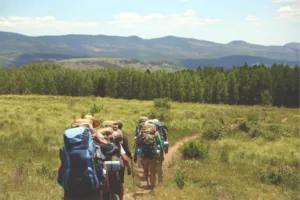Hiking with a baby can be a rewarding and enjoyable experience for the whole family. It’s a great way to get outdoors, bond with your baby, and teach them about nature. However, it’s important to be prepared before you hit the trail. This guide will provide you with everything you need to know about baby hiking, from choosing the right trail to packing for a successful trip.
Benefits of Baby Hiking
Hiking with your baby offers numerous benefits for both you and your little one. Here are some key advantages:
1. Physical Activity and Health: Hiking is an excellent way to promote physical activity and maintain a healthy lifestyle for both you and your baby. It helps strengthen your muscles, improve cardiovascular health, and burn calories.
2. Bonding and Quality Time: Hiking provides an opportunity for you to spend quality time with your baby in a natural setting. The shared experience of exploring the outdoors together can strengthen your bond and create lasting memories.
3. Sensory Stimulation: Hiking exposes your baby to various sensory experiences, such as different textures, sounds, and smells. This can help stimulate their senses and promote cognitive development.
4. Nature Appreciation: Hiking allows your baby to appreciate the beauty and wonders of nature. It can foster a sense of respect for the environment and encourage them to connect with the natural world.
5. Stress Relief: Spending time in nature has been shown to reduce stress and improve mood. Hiking with your baby can provide a refreshing escape from daily routines and help you both relax and de-stress.
6. Sleep Improvement: The physical activity and fresh air during a hike can help improve your baby’s sleep quality. A tired baby is often a happy baby, and a good night’s sleep can benefit both you and your little one.
Choosing the Right Trail
Selecting the right trail for a baby hike is crucial for a safe and enjoyable experience. Consider the following factors when choosing a trail:
- Terrain: Opt for trails with smooth, well-maintained surfaces to avoid rough terrain that could be challenging for both you and your baby.
- Distance: Choose a trail that is appropriate for your baby’s age and abilities. Start with shorter trails and gradually increase the distance as your baby gets older and more comfortable with hiking.
- Elevation Gain: Consider the elevation gain of the trail. Steep trails can be challenging for both you and your baby, especially if you are carrying them in a carrier or backpack.
- Trail Conditions: Check the trail conditions before your hike. Avoid trails that are muddy, icy, or have obstacles like fallen trees or rocks that could pose a safety hazard.
- Facilities: Consider the availability of facilities along the trail, such as restrooms, water fountains, and picnic areas. These facilities can be helpful for taking breaks, changing diapers, or feeding your baby.
- Other Hikers: Choose trails that are not too crowded, especially if you are hiking with a young baby. Crowded trails can be overwhelming for both you and your baby.
Packing for a Baby Hike
Packing for a baby hike requires careful consideration to ensure you have everything you need to keep your baby comfortable, safe, and entertained throughout the hike. Here’s a comprehensive packing list to help you prepare:
1. Baby Carrier or Backpack: Choose a comfortable and supportive baby carrier or backpack that is suitable for your baby’s age and weight. Make sure it distributes weight evenly and provides adequate head and neck support.
2. Diapers and Wipes: Pack a sufficient supply of diapers and wipes to last the duration of your hike, plus a few extra in case of unexpected changes. Consider using biodegradable diapers to minimize environmental impact.
3. Snacks and Drinks: Bring a variety of healthy snacks and drinks for your baby, such as fruits, vegetables, crackers, and water. Avoid sugary snacks and drinks, as they can cause dehydration and irritability.
4. Breastfeeding or Formula: If you are breastfeeding, ensure you have a comfortable nursing bra and nursing pads. If you are using formula, pack pre-measured formula containers or a portable formula dispenser.
5. Change of Clothes: Pack a complete change of clothes for your baby, including a onesie, pants, socks, and a hat. Consider packing an extra layer of clothing in case of cold weather or unexpected spills.
6. Sun Protection: Pack a hat, sunglasses, and sunscreen with an SPF of 30 or higher to protect your baby’s delicate skin from the sun’s harmful rays.
7. First Aid Kit: Bring a small first aid kit containing essential items like bandages, antiseptic wipes, pain relievers, and a tick removal tool.
8. Emergency Contact Information: Keep a card with your emergency contact information, including your name, phone number, and the name and phone number of your baby’s doctor, easily accessible.
9. Entertainment: Pack a few small toys, books, or other entertainment items to keep your baby occupied during the hike. Consider bringing a portable sound machine or white noise app to help your baby sleep if needed.
10. Hydration: Bring plenty of water for both you and your baby to stay hydrated throughout the hike. Consider using a hydration pack or water bottle with a spout that is easy for your baby to drink from.
Safety Tips for Baby Hiking
Hiking with a baby requires careful planning and attention to safety. Here are some essential tips to ensure a safe and enjoyable hiking experience for both you and your little one:
1. Choose the Right Trail:
Select trails that are well-maintained, have a gentle gradient, and are appropriate for your baby’s age and abilities. Avoid trails with steep inclines, rough terrain, or excessive exposure to sun or cold.
2. Check the Weather Forecast:
Before embarking on your hike, check the weather forecast and be prepared for changing conditions. Dress your baby in layers so you can adjust to temperature fluctuations. Bring rain gear, sunscreen, and a hat to protect your baby from the elements.
3. Pack Essential Gear:
Carry a well-stocked backpack with essential supplies, including diapers, wipes, extra clothing, snacks, water, a first aid kit, and any necessary medications. Consider bringing a baby carrier or backpack if your baby is too young to walk the entire distance.
4. Stay Hydrated:
Babies are prone to dehydration, so ensure they drink plenty of water throughout the hike. Offer them small sips frequently, especially in hot weather or at high altitudes.
5. Take Breaks:
Plan regular breaks during your hike to allow your baby to rest, feed, or play. Look for scenic spots where you can stop and enjoy the surroundings.
6. Be Aware of Your Surroundings:
Keep an eye on your baby at all times and be aware of potential hazards such as cliffs, water bodies, or poisonous plants. Stay on designated trails and avoid venturing into unmarked areas.
7. Listen to Your Baby:
Pay attention to your baby’s cues and respond promptly to their needs. If your baby seems tired, hungry, or uncomfortable, take a break or head back to the trailhead.
8. Hike with a Partner:
Hiking with a partner allows you to share the responsibilities of carrying the baby, packing supplies, and keeping an eye on your surroundings. It also provides an extra layer of safety in case of an emergency.
Hiking with a Baby Carrier
Hiking with a baby carrier can be a great way to enjoy the outdoors with your little one. However, it’s important to choose the right carrier and to use it properly to ensure your baby’s safety and comfort.
When choosing a baby carrier for hiking, there are a few things to keep in mind:
- Support: The carrier should provide good support for your baby’s head, neck, and back.
- Comfort: The carrier should be comfortable for both you and your baby. Look for a carrier with padded shoulder straps and a wide waist belt.
- Adjustability: The carrier should be adjustable so that it can be customized to fit your body and your baby’s size.
- Safety: The carrier should meet all safety standards. Look for a carrier that has been tested and approved by a reputable organization.
Once you’ve chosen a baby carrier, it’s important to learn how to use it properly. Be sure to read the manufacturer’s instructions carefully and practice using the carrier before you go on a hike.
When hiking with a baby carrier, there are a few things to keep in mind:
- Start slowly: Don’t try to hike too far or too fast on your first few hikes. Gradually increase the distance and difficulty of your hikes as your baby gets used to being carried.
- Take breaks: Be sure to take breaks throughout your hike to give your baby a chance to stretch and move around. You should also take breaks to feed and change your baby.
- Be aware of your surroundings: Be aware of the terrain and any potential hazards, such as rocks, roots, or branches. Be careful not to trip or fall.
- Stay hydrated: Be sure to drink plenty of water before, during, and after your hike. You should also offer your baby water frequently.
- Be prepared for emergencies: Be sure to pack a first aid kit and other emergency supplies in your backpack. You should also know how to contact emergency services in the area where you’re hiking.
Hiking with a baby carrier can be a great way to enjoy the outdoors with your little one. By following these tips, you can help ensure that your hike is safe and enjoyable for both of you.
Hiking with a Toddler
Hiking with a toddler can be a rewarding experience for both parents and the little one. Toddlers are full of energy and curiosity, and hiking provides an excellent opportunity for them to explore the natural world and learn new things. However, hiking with a toddler also requires careful planning and preparation to ensure a safe and enjoyable trip.
When choosing a trail for a toddler, it’s essential to consider the distance, terrain, and elevation gain. Look for trails that are relatively short (less than 2 miles) and have a gentle gradient. Avoid trails with steep climbs or rough terrain, as these can be challenging for toddlers to navigate.
It’s also important to pack appropriately for a hike with a toddler. Bring plenty of snacks and water, as well as diapers, wipes, and a change of clothes. You may also want to pack a first aid kit and a small backpack for your toddler to carry their own snacks and water.
When hiking with a toddler, it’s essential to set realistic expectations. Don’t expect your toddler to hike for long distances or keep up with your pace. Be prepared to take breaks often and let your toddler explore the surroundings. You may also want to bring along some toys or activities to keep your toddler entertained during the hike.
Finally, always remember to supervise your toddler closely while hiking. Keep them within arm’s reach and be aware of any potential hazards, such as cliffs, water, or poisonous plants. By following these tips, you can ensure that your hike with a toddler is a safe and enjoyable experience for everyone involved.
Baby Hiking Activities
Hiking with a baby can be a wonderful way to bond with your child and enjoy the outdoors together. Here are some activities you can do during your hike to keep your baby entertained and engaged:
1. Nature Walk: Encourage your baby to explore the natural surroundings by pointing out interesting plants, animals, and rocks. Talk about the colors, shapes, and textures they see.
2. Sensory Exploration: Let your baby touch and feel different objects along the trail, such as leaves, twigs, and rocks. Describe the textures and sensations to them.
3. Singing and Storytelling: Sing songs or tell stories related to nature and the outdoors. This will help keep your baby entertained and engaged during the hike.
4. Scavenger Hunt: Create a simple scavenger hunt by hiding small objects along the trail for your baby to find. This will encourage them to explore and have fun.
5. Nature Crafts: Collect natural materials like leaves, flowers, and rocks during your hike and use them to create simple crafts with your baby. This is a great way to encourage creativity and imagination.
6. Snack Breaks: Take frequent snack breaks to keep your baby’s energy levels up. Pack healthy and nutritious snacks that are easy for your baby to eat on the go.
7. Water Play: If you come across a stream or river during your hike, let your baby splash and play in the water. This is a great way to cool off and have fun.
8. Babywearing Dance Party: If your baby is getting fussy, try dancing or swaying while wearing them in a baby carrier. The movement and music can help soothe and entertain them.
9. Baby-Friendly Games: Play simple games like “I Spy” or “Animal Sounds” to keep your baby entertained during the hike. These games can also help them learn new words and concepts.
10. Photo Opportunities: Take lots of photos of your baby during your hike. These photos will be cherished memories of your time together in nature








